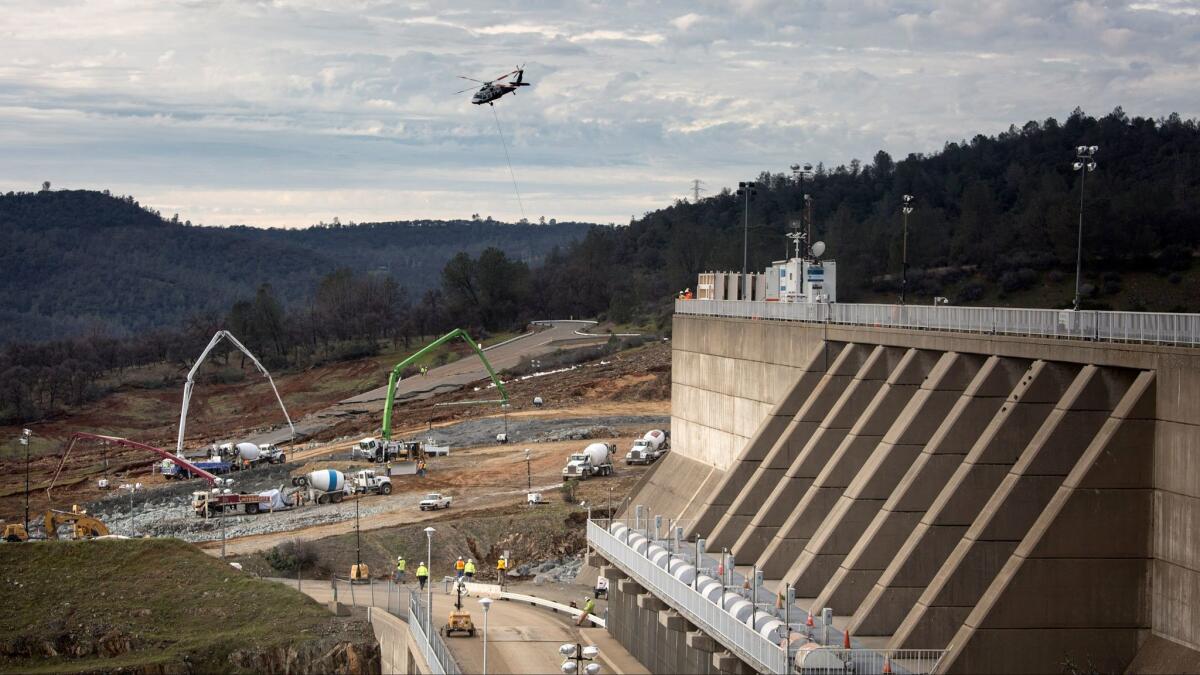Opinion: Oroville Dam is just part of California’s crumbling infrastructure

Good morning. I’m Paul Thornton, The Times’ letters editor, and it is Saturday, Feb. 18, 2017*. President Trump will be in Florida today to kick off his 2020 reelection bid with a campaign rally. No, really. Let’s take a look back at the week in Opinion.
Part of the Oroville Dam — which as the nation’s tallest such structure impounds the Feather River, creating California’s second-largest reservoir — almost failed a week ago, resulting in the panicked evacuation of more than 100,000 residents downstream and a sober assessment of the state of our water infrastructure.
Dams don’t just deteriorate overnight, so how did we get here? Victor Davis Hanson, a scholar at the Hoover Institution, blames unfocused political leaders who diverted their attention from maintaining the critical network of dams and aqueducts built by a previous generation of Californians, and instead focused on dubious progressive causes:
The 19th and 20th century dams have saved thousands of lives and billions of dollars of property from perennial spring flooding. The dam at Oroville helps to control the flows of the Feather, Yuba, and, ultimately, the Sacramento rivers, allowing millions of Californians in these former flood basins to live without fear of deluges. Many Californians have come of age taking dams like Oroville for granted, assuming that flooding was something of ancient family lore — and that the manmade storage reservoirs surrounding their growing cities were “natural” lakes.
The water projects created cheap and clean hydroelectric power. (At one point, California enjoyed one of the least expensive electric delivery systems in the United States.) In addition, dams like Oroville ensured that empty desert acreage on California’s dry west side of the Central Valley could be irrigated. The result was the rise of the richest farming belt in the world. Complex transfers of water also helped fuel spectacular growth in the San Francisco Bay Area and Los Angeles Basin. Their present populations often do not fully appreciate that their dry hillsides and Mediterranean climates could never have supported such urban growth without the can-do vision of a prior generation of hydrological engineers. …
Yet the California Water Project and federal Central Valley Project have been comatose for a half-century — despite the recent drought. Environmental lawsuits and redirection of critical state funding stalled final-phase construction, scheduled expansion and maintenance. Necessary improvements to Oroville Dam, like reinforced concrete spillways, were never finished. Nor were planned auxiliary dams on nearby rivers built to relieve the pressure on Oroville.
A new generation of Californians — without much memory of floods or what unirrigated California was like before its aqueducts — had the luxury to envision the state’s existing water projects in a radically new light: as environmental errors. To partially correct these mistakes some proposed diverting storage water for fish restoration and re-creating of wild rivers to flow uninterrupted into San Francisco Bay.
Indeed, pressures mounted to tear down rather than build dams. The state — whose basket of income, sales and gas taxes is among the highest in the country — gradually shifted its priorities from the building and expansion of dams, reservoirs, aqueducts, bridges and highways to redistributionist social welfare programs, state employee pensions and an enormous penal archipelago.
California currently hosts a third of the nation’s welfare recipients. Over one in five Californians lives below the poverty line. One in four Californians was not born in the United States. These social transformations pose enormous political challenges and demand that infrastructure and schools grow commensurately to meet soaring populations.
Instead, California is eating its seed corn.
State lawmakers spend their time obsessing over minutia: a prohibition against free grocery bags and rules against disturbing bobcats. When they do turn their attention to development, they tend to pick projects that serve urban rather than rural populations — for example, that boondoggle of a bullet train whose costs keep climbing even as the project falls years behind schedule.
The crisis at Oroville is a third act in the state’s history: One majestic generation built great dams, a second enjoyed them while they aged, and a third fiddles as they now erode.
The Oroville Dam crisis could become a Los Angeles crisis. The water cascading down the dam’s defective spillway may end up in the toilets and sinks of Southern California residents, who depend on the wet weather of the state’s northern section to make their existence in a dry climate possible, notes The Times Editorial Board. “There will likely be lessons learned about how the state should manage water from the emergency at Lake Oroville, but it is too early at this point to be certain what they are,” the board writes. “Meanwhile, Californians will have to keep the names and distant places — the Feather River, the Oroville Dam, the Owens, the Colorado, Lake Mead — in the forefront of their minds as we make decisions to sustain, supplement or abandon the water projects that have made the state what it is today.” L.A. Times
Dams are like loaded weapons, and the crisis at Lake Oroville could be the first of many potential catastrophes to come, writes Opinion contributor Jacques Leslie. Southern California residents have been underpaying for the water they use from the lake for years, resulting in necessary maintenance on the Oroville Dam and other structures going undone for years. Now, the residents of Oroville, Calif., just miles from the crippled dam, may pay dearly for our neglect. L.A. Times
It’s spending time. The New York Times’ editorial board sees the scramble to save the Oroville Dam as a “parable on infrastructure” in the United States, noting that the American Society of Civil Engineers gave the country’s dams an average grade of “D” and called for billions to be spent on repairs. The New York Times believes President Trump’s plan to spend $1 trillion on infrastructure may not be suitable for the task of fixing the nation’s aging dams if it relies on tax credits to spur the work that needs to be done. New York Times
Trump ranted and raved that he does not rant and rave. The leaks about Michael Flynn are real, but the news about them is fake because, well, the news is fake. There’s no chaos at the White House; in fact, it’s being run like a fine-tuned machine. There’s nothing to worry about with Russia. Trump is the least racist president ever. The point of all this, delivered in the president’s meandering news conference Thursday, according to columnist Doyle McManus: Don’t worry, Americans, because President Trump is in control. L.A. Times
There’s another election in less than three weeks, which means it’s endorsement season at The Times’ opinion page (kind of feels like that all the time, no?). Citizens in Los Angeles will go the polls on March 7 to vote on the mayor, their City Council members and their representatives on the Los Angeles Unified School District’s Board of Education. They’ll also decide on important local ballot measures, including an effort to halt most development in the city and spend billions on housing and services for homeless people. The Times’ Editorial Board has made recommendations in many of these races; click here to find them.
*Last week, I mistakenly jotted down the year as 2016. Thanks to several readers for noting my error.
Reach me: [email protected]
